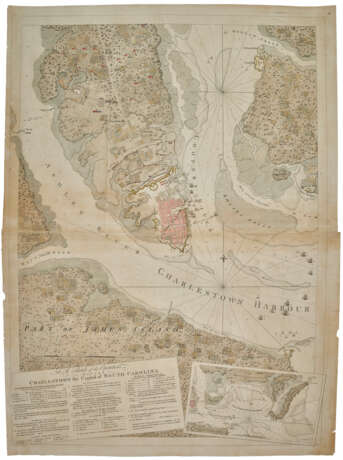ID 1119186
Lot 108 | A Sketch of the Operations before Charlestown the Capital of South Carolina
Valeur estimée
$ 12 000 – 18 000
Joseph Frederick Wallet des Barres, 1780
DES BARRES, Joseph Frederick Wallet (1729-1824). A Sketch of the Operations before Charlestown the Capital of South Carolina. [London: 17th June 1780].
An important large-scale map of Charleston Harbor during the Revolutionary War: the rare first state, printed on Bates paper and with the imprint intact. RBH records just two copies at auction since 1990, both in later states. Following the failure of major strategic efforts in the north, the British shifted their focus to the American Southern Colonies, launching the siege of Charleston on 1 April 1780. The present map depicts the fortifications, encampments and vessels involved in the six-week siege that forced American troops, on May 12, 1780, into their largest surrender of the war. “The most useful single plan for interpreting this campaign. The very large scale enables depiction of the military information pertaining to Clinton’s successful siege of Charleston in great detail. The British forces are shown by regiment, keyed to the lengthy descriptive references. The parallels of the investment and defensive lines are clearly shown […] The ships of both fleets are illustrated; the legend names them and indicates number of guns for each” (Nebenzahl 80).
Joseph Frederick Wallet Des Barres emigrated to England from Switzerland in the 1750s, having studied at the University of Basel under the great mathematicians David and James Bernouilli. After training as a military engineer at the Royal Military College at Woolwich he was appointed lieutenant in the Royal American Regiment of Foot (the 60th, composed largely of foreign officers) in 1756. One of his fellow officers was the surveyor Samuel Holland, a Dutchman, the future surveyor general of the Northern District of North America, who in 1758-59 instructed the young Captain James Cook in the art of surveying. Holland and Cook were Des Barres's principal collaborators on the Atlantic Neptune.
In 1763, recognizing the Navy's acute need for satisfactory charts of the North American coast, the British Admiralty engaged Des Barres to conduct a systematic survey of the entire eastern Seaboard. He spent the next ten years surveying the coasts of Nova Scotia, the dreaded Sable Island (site of innumerable shipwrecks, on which he spent two years), and parts of New Brunswick. Returning to England in 1774, Des Barres devoted the next decade to publishing his own surveys, including his magnificent Atlantic Neptune in which this map appeared. Stevens, Catalogue, 164(a).
Large engraved map on two sheets joined, the whole 1097 x 792mm, the land areas in contemporary hand color, title in cartouche to bottom left above key naming the various fortifications, encampments, vessels and quarters during the siege, inset vignette map of the wider harbor to bottom right, imprint intact below scale, printed on Bates paper (repaired chip to blank lower left corner, several small marginal tears or nicks, most repaired, one or two extending unobtrusively into the printed area, the join strengthened on verso, some minor discoloration to join and areas of the margin).
| Adresse de l'enchère |
CHRISTIE'S 20 Rockefeller Plaza 10020 New York Etats-Unis | ||||||||||||||
|---|---|---|---|---|---|---|---|---|---|---|---|---|---|---|---|
| Aperçu |
| ||||||||||||||
| Téléphone | +1 212 636 2000 | ||||||||||||||
| Fax | +1 212 636 4930 | ||||||||||||||
| Conditions d'utilisation | Conditions d'utilisation | ||||||||||||||
| transport |
Service postal Service de messagerie ramassage par vous-même | ||||||||||||||
| Modes de paiement |
Virement bancaire | ||||||||||||||
| Heures d'ouverture | Heures d'ouverture
|



